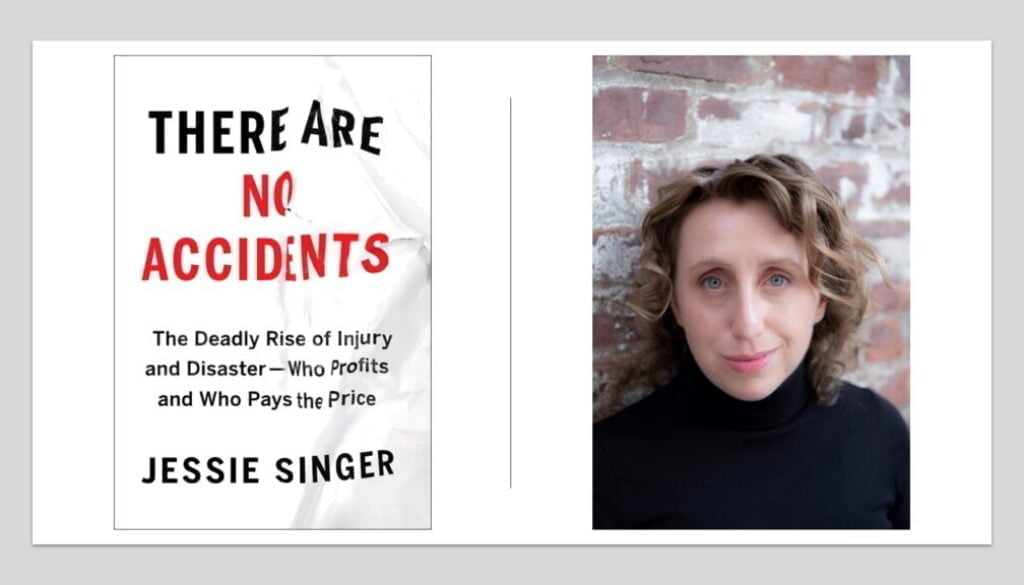There Are No Accidents: An Interview with Author Jessie Singer, Part 2
Jarron Saint OngeWe welcome Jessie Singer to the IAPHS Blog to discuss their new book, There Are No Accidents: The Deadly Rise of Injury and Disaster—Who Profits and Who Pays the Price. In this book, Singer discusses the importance and implications of the way we report, frame, and respond to accidents and accident-related deaths.
Following is Part 2 of the interview. In part 1, we discussed the framing of accidents and importance of recognizing our biases in policy decisions. Part 3 discusses the role of population health scientists in communicating and helping improve systems and policies.
The interviews have been lightly edited and condensed for space and clarity.
So you have been talking a lot about the built and social environments. Is there a way that you think we can better approach our understanding of environments in order to reduce accidents?
Yes, absolutely. We have a psychological tendency to try to change people’s behavior instead of their surroundings. As suggested in the fundamental attribution error, we see other people’s accidents as a product of their personal failures, and our accidents as a problem of the environment. When we try to solve the accident problem, we’re fighting against these base psychological biases, but the truth is that the built environment is entirely in the control of policymakers and corporations, and all accident prevention lies there.
Preventative solutions can be built into the environment, but instead we just scold people. A better answer is providing resources that earnestly look at what people need and how they react.
For example, you could put up a series of billboards that say, “Drive slower,” which is something government officials recently did in New York City. Now, research shows us that public service announcements like these do not work. But if you make the street narrower, research shows us that drivers slow down — not because they’re concerned about the person they might hurt, but because they’re scared for themselves. It feels less safe to drive fast on a narrow street. You can build an environment that induces better behavior based on what affects people, accepting their selfishness rather than purity-test moralizing that asks people to behave better for unknown strangers.
We can see a similar version of this idea in naloxone, a miracle drug that was invented in the 1960s, and which could be distributed with every single opioid prescription in this country and which instead is almost impossible to get. Instead we tell people to not use drugs. Naloxone has the ability to shift the social environment by saying, “if you made a mistake, you don’t deserve to die,” which is really different than saying, “don’t make a mistake.”
Earlier we discussed disparities and equity in accidents. Can you discuss a bit more about the role of inequality in policy solutions?
Accidental death tracks with income inequality. This was true in the industrial revolution and it’s true today. When income inequality is high, accidental death is high. When income inequality is low, accidental death is low. Following high numbers of accidental deaths in the Industrial Revolution, unions successfully fought to institute workers’ compensation and workplace safety laws, and these changes to the infrastructure and policy of the built environment began a decline in worker deaths.
But other accidental deaths rose in that period—namely traffic fatalities. Then in the 1960s and 1970s, social justice movements pushed the government to remarkable action that changed the paradigm for some time: we created federal regulatory institutions, and we expanded the social safety net.
Regulatory agencies protect us from the ways that corporations can cause our accidental death by putting a price on risk. When corporations put our lives at risk, whether it is with unsafe products, unsafe workplaces, unsafe airplanes, or unsafe cars, there’s a cost to their bottom line that encourages their compliance. The role of the social safety net in preventing accidental death is less intuitive but no less important; it gives people the resources to protect themselves. If you feel financially secure, you don’t need to take the most dangerous job even if it pays more. You don’t need to live in the cheapest apartment that you know is a fire trap. You can afford to buy a safer new car. In this way, both the social safety net and the regulatory network protect us, even if we make mistakes.
The actions of our regulatory agencies and the expanded social safety net reduced the accidental death rate for decades, until 1992. But the accidental death rate has been rising ever since, the after-effect of President Ronald Reagan dismantling both the social safety net and defanging our regulatory agencies.
Today, we’re on our own – leading to wildly unequal rates of accidental death. We often see these as the product of individual mistakes, but they’re actually the result of regulatory failure and economic inequality. Take a traffic accident, for example. Imagine two speeding drivers, one poor and one rich. Both drivers make the bad decision to speed. Both drivers crash. But one could afford the extra $10,000 to get an automatic emergency braking package in their car, so that driver, the rich driver, has a better chance of surviving a crash. One driver is more protected.
If our government wasn’t so cowardly and was actually regulating corporations, we could protect both of those drivers by regulating automakers to force the installation of automatic emergency braking in all cars and ensuring that the social safety net could allow both of those drivers to buy a safer car.
Regulations and the built environment can be somewhat economically universal, so they have the potential to protect everyone equally and provide a sort of umbrella across class and race lines – directly reducing accidental death rates. This is one reason that the U.S. leads wealthy nations in accidental deaths. In other wealthy nations, corporations are forced to spend profits creating the safest possible products, and governments spend tax dollars on policies and public infrastructures that reduce the likelihood of accidental death –whether that’s vehicle regulations, or making sure public housing is fire safe, or providing universal health care so that someone can treat their pain with the help of a doctor rather than with the help of illegal drugs.
You use a lot of examples in your book on traffic accidents. Can you also comment on more stigmatized forms of accidental deaths and the role of stigma in policy?
Generally, stigmatized “accidents” are the most solvable but most ignored types of accidental death. If we consider most accidents to be the problem of people’s mistakes and bad decisions, the stigmatized accidents we exaggerate into something larger and more nefarious – these sort of “bad people problems.”
But truly all accidents are the same, in the way that different people are exposed to different levels of risk and in the way that we pretend accidental death is a matter of human error. For example, my local government has been responding to a rise in traffic fatalities by putting up “speeding kills so don’t be a bad person who’s a speeder” on local billboards. It’s just another version of “don’t do drugs.”
The work we need to do with stigmatized accidents and less-stigmatized accidents is to constantly connect them, to make the point that all of these things that we call “accidents” are the same. A traffic crash is the same as a drug overdose, because in the end, the mechanism of injury is the same: the release of dangerous, harmful energy. We control the harm of either accident by creating policies and infrastructure that allow the control of that harmful energy – whether that’s a bollard that protects a sidewalk or a pharmacist who hands out naloxone.
We need to keep reducing the stigma of these stigmatized deaths by stressing that they are one in the same. We fail in our responses to these accidents when we fail to see them as connected. To solve either, we need to overcome this “bad people” narrative and focus on a harm reduction one.
Can you give an example of a harm reduction approach?
You can reduce the harm of speeding with automatic emergency breaking and speed governors and narrow roads, which are just ways to control the energy of a car. You can reduce the harm of drug use with clean syringes and safe injection sites and with naloxone, which reduce the harm of using drugs. Until we focus on the harm, how it’s caused, and the degree of impact, we’re not actually ever going to solve the problem. We’re just going to talk about different degrees of “bad people.”
Consider how we treat speeding and DUIs differently. As you likely know, speeding is never enforced at the speed limit. You don’t get a ticket for going one mile over the speed limit, but you will for going 10 or more miles over the speed limit, and that’s written into law in many places. But driving under the influence is enforced at 0.1 over the limit. Although a similar number of people are killed in crashes involving speed and DUI, only one of those behaviors is stigmatized, and the other is considered “something that everyone does” and so we respond with different severity. It is just a way of telling the simplest story after an accident, and that story is you’re good and they’re bad. From that too basic binary, we get exactly zero solutions.
Check back for our third in this three-part series to find out how population health scientists can better communicate with journalists like Jessie to help reduce harm, injury, and death.
There Are No Accidents: The Deadly Rise of Injury and Disaster—Who Profits and Who Pays the Price is available now from Simon and Schuster publishing.





All comments will be reviewed and posted if substantive and of general interest to IAPHS readers.